Personal Transportation Factsheet
In the U.S., the predominant mode of travel is by automobile and light truck, accounting for 87% of passenger miles traveled in 2020.1 The U.S. has just over 4% of the world’s population, but has 12% of the world’s cars, compared to 19.6% in China, 5.7% in Japan, 4.4% in Germany, and 4.9% in Russia.2,3 The countries with the most growth in registered cars since 1990 are China (18%), India (9.8%), and Indonesia (9.6%).3 The transportation use patterns that follow indicate that the current system is unsustainable.
Patterns of Use
Miles Traveled
- Total U.S. person-miles traveled in 2020 were 4.95 trillion.1
- U.S. population increased 36% from 1990 to 2022. Vehicle miles traveled (VMT) increased 35% over the same time period.1,2,4
- 69% of the total annual vehicle miles traveled in the U.S. occur in urban areas.1
Vehicles and Occupancy
- In 1977, the U.S. average vehicle occupancy was 1.87 persons per vehicle.5
- In 2019, average car occupancy was 1.5 persons per vehicle.3
- In 2020, the U.S. had 276 million registered vehicles and 228 million licensed drivers.1
- In 2017, 24% of U.S. households had three or more vehicles.6
Average Fuel Economy
- The average vehicle fleet fuel economy peaked at 22.0 miles per gallon (mpg) in 1987, declined until the early 2000s, then increased again surpassing 22.0 mpg in 2009.7
- The average fuel economy for a 2021 model year vehicle was 25.4 mpg: 31.8 mpg for a new passenger car (sedan/wagon and car SUV) and 23.0 mpg for a new truck (truck SUV, minivan/van, and pickup).7
- Given the legislation in place, the U.S. has some of the lowest fuel economy standards of any industrialized nation, well below the European Union, China, and Japan.8
MPG by Model Year, 1975-20217
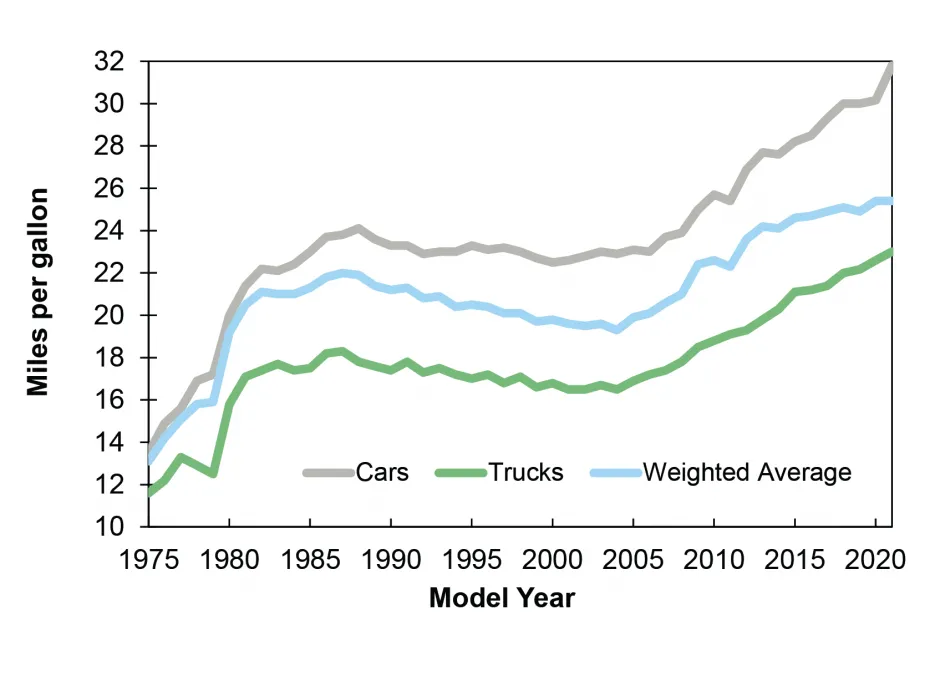
Vehicle Size
- From 1990 to 2021, average new vehicle weight increased 25% (due to SUV market share growth), horsepower increased by 87%, and acceleration increased (i.e., 0-60 mph times dropped) by 33%.7
- During the same period, the average weight of a new passenger car increased 12%, while the average weight of a new pickup truck increased by 32%.7
- SUVs, vans, and pickups accounted for 63% of new vehicles sold in the U. S. in 2021.7
- A study from the University of Michigan recommends following green lightweighting principles to reduce vehicle mass and improve energy efficiency.9
Market Share by Vehicle Type, 1975-20217
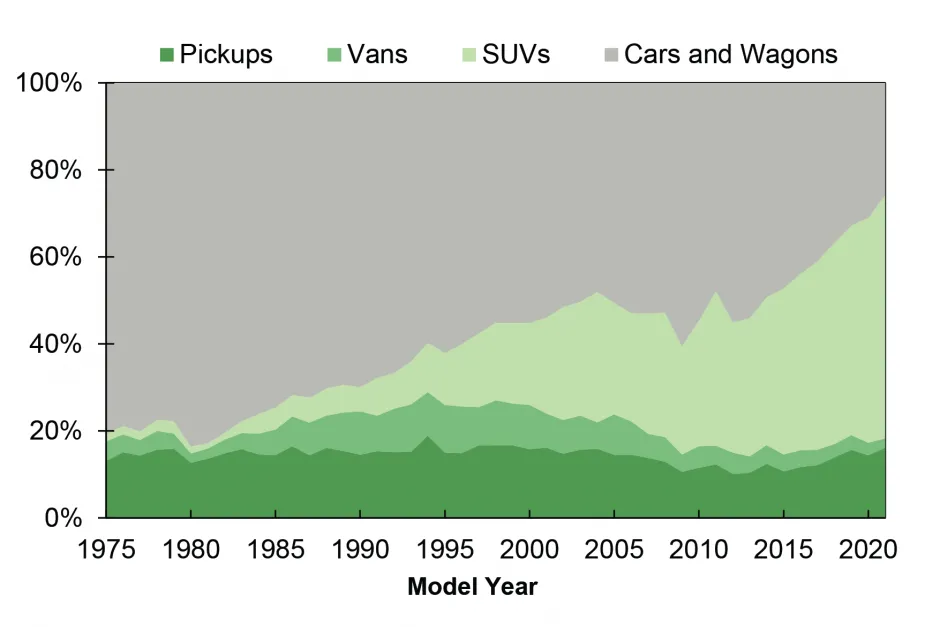
Energy Use
- The transportation sector makes up 28% of total U.S. energy use. Since 1990, the energy use in the transportation sector grew by 20%, though the share of U.S. energy used for transportation increased by 1 percent.3
- In 2019, American cars and light trucks used 15.1 quadrillion Btus of energy, representing 15% of total U.S. energy consumption.3
- In 2022, 94% of total primary energy used for transportation came from fossil fuels; 90% of total primary energy was from petroleum.10
- The transportation sector accounted for 28.5% of U.S. greenhouse gas emissions in 2021—1,804 million metric tons (Mt) CO2e.11
- In 2021, passenger cars and light-duty trucks were responsible for 374 Mt CO2e and 672 Mt CO2e, respectively, together making up 58% of U.S. transportation emissions and 16% of total U.S. emissions.11
Life Cycle Impacts
A typical passenger car is responsible for various burdens during its lifetime (raw material extraction through end-of-life). Most of these impacts are due to fuel production and vehicle operations. Vehicle lifetime energy use for fuel production and vehicle operations is 1.22 and 4.54 MJ/mi, respectively, while energy use for material production, manufacturing, maintenance, and end-of-life combined is only 0.56 MJ/mi.12
Total Life Cycle Burdens, 2016 Mid-Size Sedan12
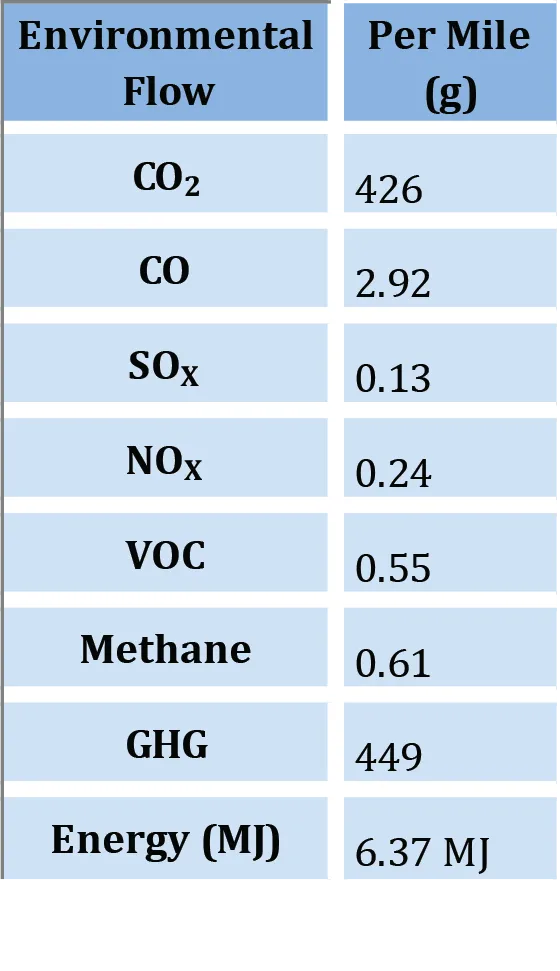
Solutions and Sustainable Alternatives
Reduce Vehicle Miles Traveled
- Live closer to work. Driving to/from work represents 30% of vehicle miles driven, and the average commute is 12 miles.3 Consider telecommuting or working from home if possible.
- In 2020, 74.9% of workers in the U.S. commuted by driving alone, and only 9% of workers carpooled (a drop from 19.7% in 1980).3 Joining a carpool can help lower household fuel costs, prevent GHG emissions, and reduce traffic congestion.
- Roughly one-fifth of vehicle trips are shopping-related. Combine errands (trip chaining) to avoid unnecessary driving.3
- In 2019, traffic congestion caused Americans to spend an extra 8.7 billion hours on roads and burn an additional 3.5 billion gallons of gas. Using alternative modes of transportation, such as bikes, buses, or trains can reduce GHG emissions and decrease wasted time and money.13
- Micromobility (e.g., bikes, scooters, etc.) and shared transportation services (e.g., bike shares) have grown rapidly in recent years. In 2019, 136 million trips were taken by shared micromobility users, more than 6 times the number of trips taken in 2015.3
U.S. Modes of Transportation to Work, 20203
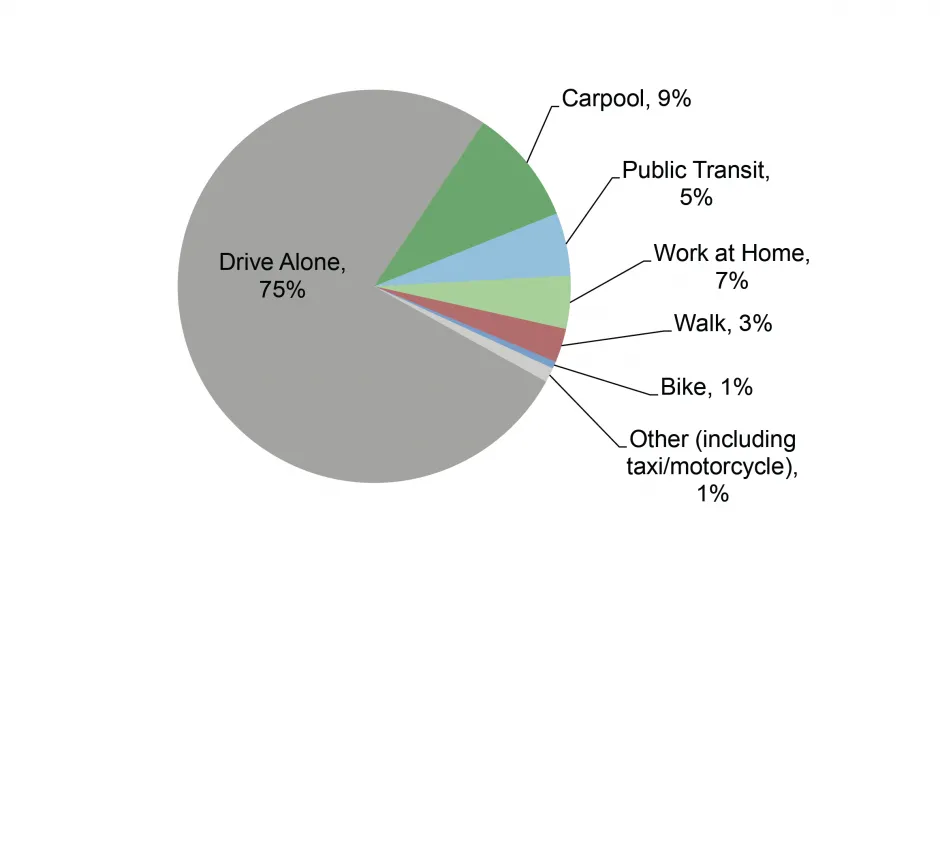
Energy Intensity of U.S. Passenger Travel, 20193 (With average persons per vehicle in parentheses)
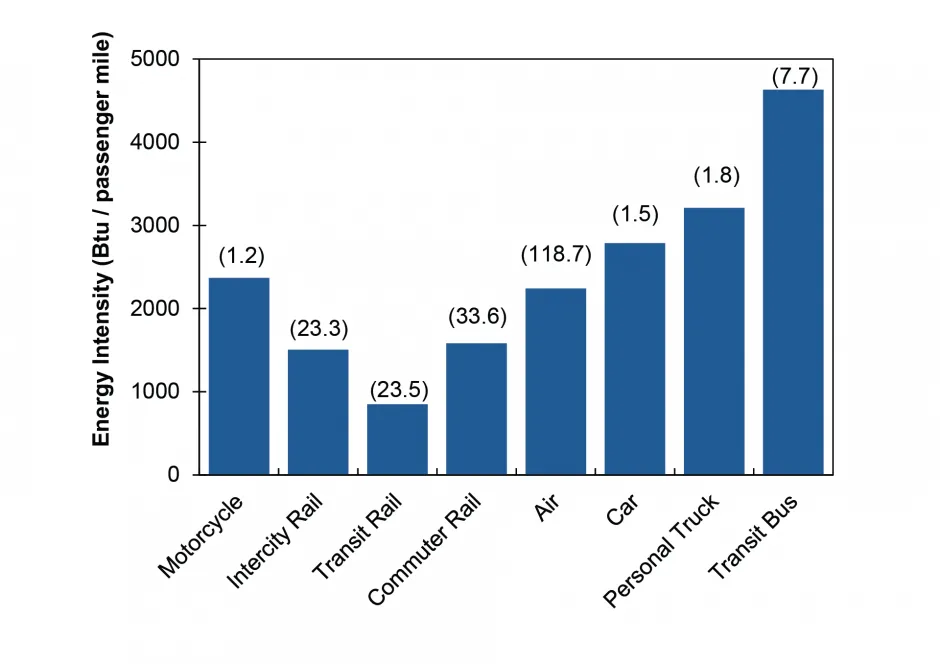
Promote Energy Efficiency
- Consider buying a vehicle that is best-in-class for fuel economy. Each year, the U.S. Environmental Protection Agency and Department of Energy jointly publish the Fuel Economy Guide, which ranks the most efficient vehicles in production.14
- Drive responsibly. Aggressive driving habits can lower fuel efficiency by 10% to 40%, and speeds over 50 mph significantly lower gas mileage.15
- Gallons per mile (gpm) is a better indicator of fuel efficiency than mpg. For example, upgrading from a 16 mpg to 20 mpg vehicle saves 125 gallons of fuel over 10,000 miles, whereas upgrading from a 34 to 50 mpg vehicle saves 94 gallons over 10,000 miles.16
- Improvements in information technology related to vehicles such as automation and platooning will likely reduce energy wasted from drivers stuck in traffic.17
- When driving electric vehicles, use battery charging best practices to maximize battery life and minimize GHG emissions.18
Encourage Supportive Public Policy
- Dense, mixed-use communities encourage foot and bike travel while reducing time between residences, businesses, and office spaces.
- In 2012, the Obama National Highway Traffic Safety Administration (NHTSA) set stringent fuel economy and GHG emissions standards.19 In 2020, the Trump NHTSA and EPA significantly weakened these standards.20 In 2022, the Biden administration directed the NHTSA to revise the current standards. The final rule set the fuel economy standards to approximately 49 mpg for passenger cars and light trucks by 2026.21 The next set of fuel economy and GHG standards, for new sales in Model Year 2027 and later, will determine whether U.S. light vehicles can do their fair share toward meeting long-term climate goals.22
- Some believe that fuel economy standards tied to vehicle size could incentivize a market shift toward larger vehicles (current trend). A University of Michigan study predicted vehicle size increases of 2-32%, which could undermine the progress made in fuel economy by 1-4 mpg.23
Center for Sustainable Systems, University of Michigan. 2023. "Personal Transportation Factsheet." Pub. No. CSS01-07.
References
- U.S. Department of Transportation (DOT), Federal Highway Administration (FHWA) (2023) Highway Statistics 2020.
- U.S. Central Intelligence Agency (CIA) (2023) The World Factbook.
- U.S. Department of Energy (DOE), Oak Ridge National Lab (2022) Transportation Energy Data Book Edition 40.
- U.S. Census Bureau (2000) Intercensal Estimates of the United States Resident Population by Age and Sex: 1990-2000.
- U.S. DOT (1981) Vehicle Occupancy: Report 6, 1977 National Personal Transportation Study.
- U.S. DOT (2019) 2017 National Household Travel Survey.
- U.S. Environmental Protection Agency (EPA) (2022) The 2022 EPA Automotive Trends Report.
- International Council on Clean Transportation (2020) Passenger vehicle fuel economy.
- Lewis, G., et al. (2019) Green Principles for Vehicle Lightweighting
- U.S. Energy Information Administration (EIA) (2023) Monthly Energy Review May 2023.
- U.S. Environmental Protection Agency (EPA) (2023) Inventory of U.S. Greenhouse Gas Emissions and Sinks: 1990-2021.
- Argonne National Laboratory (2023) The Greenhouse gases, Regulated Emissions, and Energy use in Technologies Model (GREET) 2022.
- Schrank, D., et al. (2021) 2021 Urban Mobility Report. Texas Transportation Institute.
- U.S. DOE and U.S. EPA (2023) Fuel Economy Guide.
- U.S. DOE, Energy Efficiency and Renewable Energy (2018) “Driving More Efficiently.”
- Larrick, R. and J. Soll (2008) “The MPG Illusion.” Science, 320(5883): 1593-94.
- Shoup, D. (2006) Cruising for parking. Transport Policy, 13(6): 479-486.
- Woody, M., et al. (2021) Charging Strategies to Minimize Greenhouse Gas Emissions of Electrified Delivery Vehicles
- The White House Office of the Press Secretary (2012) “Obama Administration Finalizes Historic 54.5 MPG Fuel Efficiency Standards.”
- National Highway Traffic Safety Administration (NHTSA), U.S. EPA (2020) The Safer Affordable Fuel-Efficient (SAFE) Vehicles Rule for Model Years 2021–2026 Passenger Cars and Light Trucks ; Final Rule. Federal Register, 85:84.
- National Highway Traffic Safety Administration (NHTSA) (2022) Corporate Average Fuel Economy Standards for Model Years 2024-2026 Passenger Cars and Light Trucks ; Final Rule. Federal Register, 87:84.
- Environmental Protection Network (EPN) (2021) EPN Comments on Revised 2023 and Later Model Year Light-Duty Vehicle Greenhouse Gas Emissions Standards.
- Whitefoot, K. S., & Skerlos, S. J. (2012) Design incentives to increase vehicle size created from the U.S. footprint-based fuel economy standards. Energy Policy, 41, 402–411.
